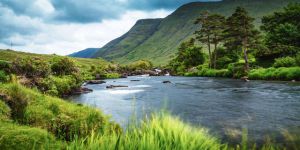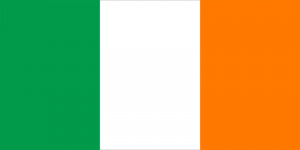Language/Irish/Vocabulary/Nature-and-Environment
Dia dhaoibh! (Hello!)
In today's lesson, we will be exploring the Irish Gaelic vocabulary related to nature and the environment. Ireland is renowned for its natural beauty, from the Cliffs of Moher to the rolling hills of the countryside, and its language reflects this appreciation for the natural world. Understanding the vocabulary related to nature and the environment is crucial for effective communication in Irish Gaelic, whether you are a tourist exploring the country's landscapes or simply wishing to expand your language skills. So, let's get started and explore the fascinating world of Irish Gaelic nature vocabulary.
Consider broadening your understanding by checking out these related lessons: Food, Sports, Seasons & Days of the week.
nádúr - nature[edit | edit source]
| Irish (Gaeilge) | English |
|---|---|
| feirm
feirmeoir |
farm
farmer |
| talamh | land |
| cré, ithir | earth, soil |
| cré | clay |
| láib, lathach | mud |
| deannach, smúit | dust |
| féar | grass |
| tuí, cochán | straw |
| fear, fear tirim
coca féir |
hay
haystack |
| fréamh(acha) | root(s) |
| duilleog(a) | leaf / leaves |
| bláth(anna) | flower(s) |
| lus na gréine | sunflower |
| rós(anna) | rose(s) |
| giúis | fir, evergreen |
| péinne, giúis / crainn ghiúise | pine(s) |
| crann / crainn | tree(s) |
| adhmad | wood |
| coill | forest |
| páirc | park |
| fear dóiteáin
lucht múchta dóiteán |
fireman / firemen |
| dóiteán / dóiteáin | conflagration |
| tine | fire |
| deatach | smoke |
| luaithreach | ashes |
| bolcán | volcano |
| sliabh / sléibhte | mountain(s) |
| cnoc / cnoic | hill(s) |
| uaimh | cave |
| gleann | valley |
| damba | dam |
| eas | waterfall |
| loch | lake |
| linn | pond |
| riasc / riasca | marsh(es) |
| portach | bog, (quag)mire |
| machaire / machairí | plain(s) |
| móinéar | meadow |
| féarach | pasture |
| páirc / páirceanna | field(s) |
| muileann gaoithe
muileann uisce |
windmill
watermill |
| droichead | bridge |
| abhainn / aibhneacha | river(s) |
| farraige, muir | sea |
| aigéan | ocean |
| feamainneacha | seaweeds |
| cúr, cúran | foam |
| gal | steam, vapor |
| oileán / oileáin | island(s) |
| trá | beach |
| dumhach / dumhcha | dune(s) |
| gaineamh | sand |
| púróg(a), méaróg(a) | pebble(s) |
| cloch(a) | stone(s) |
| carraig | rock |
| marmar | marble |
| diamant(aí) | diamond(s) |
| rúibín | ruby |
| saifír | sapphire |
| smaragaid | emerald |
| ómra | amber |
| gaing | jet |
| gual | coal |
| ola, peitriliam | oil, petroleum |
| gás | gas |
| miotal / miotail | metal(s) |
| luaidhe | lead |
| stáin | tin |
| iarann | iron |
| cruach | steel |
| airgead | silver |
| copair | copper |
| ór | gold |
Importance of Nature and Environment in Ireland[edit | edit source]
The importance of nature and the environment in Ireland cannot be overstated. With its stunning landscapes, from rugged coastlines to rolling green hills, Ireland has become known for its natural beauty. The environment is a crucial aspect of the country's identity and culture, with many traditional customs and beliefs rooted in the natural world. The landscape also plays an essential role in the country's tourism industry, attracting millions of visitors each year. The Irish government has recognized the importance of protecting the environment, and numerous initiatives have been implemented to conserve natural resources and protect wildlife. Furthermore, many Irish citizens actively engage in environmentally-friendly practices, such as recycling and reducing energy consumption.
The natural environment in Ireland is home to numerous flora and fauna species, many of which are unique to the island. For example, Ireland is famous for its wild Atlantic salmon, which migrate from the ocean to freshwater rivers to spawn. Additionally, the country is home to the Irish hare, a species that is only found in Ireland and is a significant symbol in Irish folklore. Many Irish people also have a strong connection to their local environment, with many traditional customs and practices tied to specific locations. For instance, St. Brigid's Day, a traditional Irish festival, is celebrated on February 1st, and involves the making of St. Brigid's crosses, which are made from rushes gathered from local fields. The landscape of Ireland is also a crucial aspect of the country's tourism industry, with visitors from all over the world coming to see the Cliffs of Moher, the Ring of Kerry, and other iconic natural landmarks. In recent years, the Irish government has implemented numerous environmental policies, such as the introduction of a plastic bag tax, to encourage sustainable practices and protect the natural environment.
Videos[edit | edit source]
How Irish Connects Us With Nature[edit | edit source]
Other Lessons[edit | edit source]
- At the post office
- Weather and Climate
- Hobbies
- How to Say Hello and Greetings
- Sports
- Seasons
- Food
- Feelings and Emotions
- House


